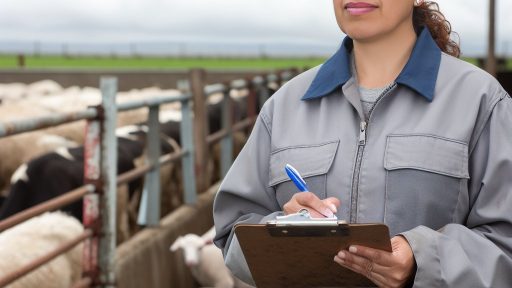Overview of Food Safety Standards in Agriculture
Definition of Food Safety Standards
Food safety standards refer to the regulations that ensure the safety of food products.
These standards help to protect consumers from foodborne illnesses.
They also establish protocols for food production and processing.
Importance of Food Safety Standards
Food safety standards are crucial for maintaining public health.
They reduce the risk of contamination in food systems.
Moreover, they enhance consumer confidence in agricultural products.
Key Components of Food Safety Standards
- Hygiene practices for food handlers.
- Safe food storage and handling procedures.
- Regular inspections and audits of food facilities.
- Traceability systems for food products.
Global Food Safety Initiatives
Organizations like the World Health Organization promote global food safety initiatives.
These initiatives provide guidelines for countries to ensure safe food supply chains.
They also support training programs for food industry professionals.
Regulatory Bodies
Various regulatory bodies oversee food safety standards.
For example, the U.S. Food and Drug Administration sets guidelines for food products in the United States.
Similarly, the European Food Safety Authority monitors food safety across Europe.
The Role of Technology in Food Safety
Technological advancements improve food safety protocols.
For instance, data analytics enhance traceability in the food supply chain.
Additionally, automation helps to minimize human error in food production.
Transform Your Agribusiness
Unlock your farm's potential with expert advice tailored to your needs. Get actionable steps that drive real results.
Get StartedHistorical Context: Evolution of Food Safety Regulations
The Beginnings of Food Safety Regulations
The roots of food safety date back to ancient civilizations.
Early societies recognized the need for clean food handling.
For instance, ancient Greeks practiced sanitation in food preparation.
Similarly, the Roman Empire implemented laws for food quality.
Milestones in Food Safety Legislation
The advent of the Industrial Revolution marked significant changes.
Rapid urbanization led to increased food production and consumption.
Consequently, food safety concerns grew, prompting government action.
In the United States, the Pure Food and Drug Act emerged in 1906.
This act addressed mislabeling and unsafe food products.
Global Developments in Food Safety Standards
Globalization has further shaped food safety regulations.
International trade brought diverse food products to new markets.
As a result, organizations like the Codex Alimentarius were formed.
This body established international food safety standards.
Countries began aligning their regulations with global guidelines.
Modern Food Safety Standards
Today, food safety standards continue to evolve.
Technological advances influence how safety is maintained.
Innovations like blockchain are enhancing traceability.
Moreover, foodborne illnesses have prompted stricter regulations.
The FDA and USDA actively enforce food safety guidelines.
Challenges and Future Directions
Despite progress, challenges remain in food safety regulation.
Global supply chains complicate monitoring and enforcement.
Additionally, climate change impacts food production and safety.
Future regulations must adapt to these emerging challenges.
Ultimately, ensuring food safety is a shared responsibility.
Showcase Your Farming Business
Publish your professional farming services profile on our blog for a one-time fee of $200 and reach a dedicated audience of farmers and agribusiness owners.
Publish Your ProfileThe Role of Government and Regulatory Bodies in Implementing Food Safety
Establishing Food Safety Regulations
Governments create guidelines to ensure food safety standards are met.
These regulations help protect public health and ensure food quality.
Regulatory bodies, such as the FDA and USDA, oversee compliance.
They conduct inspections and enforce food safety laws.
Additionally, these organizations evaluate food safety research.
Monitoring and Enforcement
Governments actively monitor food production practices.
They use inspections to enforce compliance with safety standards.
Non-compliance can lead to penalties for producers.
Moreover, regulatory bodies track foodborne illness outbreaks.
Collaboration with Industry
Government agencies collaborate with food industry stakeholders.
They provide training and education on best practices.
These partnerships foster a culture of food safety.
Industry participation is essential for effective regulation.
Public Awareness Programs
Governments implement public awareness campaigns on food safety.
These campaigns educate consumers about safe food handling.
They highlight the importance of checking food labels.
Furthermore, public outreach promotes responsible food consumption.
Adapting to Emerging Risks
Food safety regulations evolve to address new challenges.
Government agencies keep abreast of scientific advancements.
They also respond to emerging food safety threats accordingly.
Continuous updates are vital to maintaining food security.
Discover More: Enhancing Farm Operations Through Animal Welfare Compliance
Impact of Food Safety Standards on Public Health
Protecting Consumers
Food safety standards significantly protect consumers from foodborne illnesses.
These standards ensure that food is produced, processed, and handled safely.
As a result, fewer people get sick from contaminated food products.
Enhancing Food Quality
Implementing safety standards improves overall food quality.
High-quality food contributes to better public health outcomes.
Furthermore, it reduces the economic burden linked to healthcare costs.
Building Trust in Food Systems
Trust is essential for consumer confidence in food supply.
Food safety regulations help build and maintain that trust.
People are more likely to purchase food that meets safety standards.
Managing Food Production Risks
Food safety standards help manage risks associated with food production.
They establish protocols to minimize potential hazards.
This proactive approach protects both farmers and consumers alike.
Supporting Regulatory Compliance
These standards facilitate compliance with governmental regulations.
By adhering to regulations, producers avoid legal issues and penalties.
This compliance also reinforces a commitment to public health.
Encouraging Responsible Practices
Food safety standards promote responsible agricultural practices.
Farmers learn and implement best practices through training and resources.
This education enhances both safety and sustainability in agriculture.
Showcase Your Farming Business
Publish your professional farming services profile on our blog for a one-time fee of $200 and reach a dedicated audience of farmers and agribusiness owners.
Publish Your ProfileBenefits of Food Safety Standards
The benefits of food safety standards extend far beyond individual consumers.
They contribute to a healthier population overall.
Moreover, they foster a more robust and reliable food system.
Explore Further: Understanding Food Safety Standards for Modern Farmers
Economic Implications of Maintaining Food Safety Standards for Farmers
Protecting Farmer Income
Adhering to food safety standards protects farmers’ income from potential losses.
When safety standards are followed, farmers build consumer trust.
This, in turn, leads to increased sales in local and international markets.
Moreover, compliant products avoid costly recalls due to contamination.
As a result, farmers maintain a stable revenue stream.
Access to Markets
Food safety compliance opens new market opportunities for farmers.
Retailers increasingly prefer suppliers who meet these standards.
Moreover, international markets mandate strict safety regulations.
Thus, compliance can enhance a farmer’s reputation and competitiveness.
Farmers can leverage certifications to differentiate their products.
Cost of Non-Compliance
The cost of non-compliance can be severe for farmers.
Contaminated products can lead to significant financial losses.
Additionally, penalties from regulatory bodies can cripple operations.
Farmers may also lose contracts with distributors and retailers.
Consequently, investing in food safety becomes a prudent financial decision.
Long-Term Sustainability
Maintaining food safety standards contributes to long-term sustainability in agriculture.
Healthy crops enhance soil and ecosystem resilience.
Moreover, sustainable practices can lower input costs over time.
Farmers adopting safety standards witness improvements in crop quality.
This approach aligns with consumer demand for responsibly sourced products.
Find Out More: The Role Of Tariffs In Shaping Agricultural Markets Globally
Global Standards vs. Local Regulations: A Comparative Analysis
Understanding Global Food Safety Standards
Global food safety standards aim to ensure safe food practices worldwide.
Organizations like the World Health Organization (WHO) and the Food and Agriculture Organization (FAO) set these standards.
These guidelines help countries improve their food safety systems.
Furthermore, they facilitate international trade by ensuring product safety.
Adherence to global standards improves consumer confidence in food products.
The Role of Local Regulations in Agriculture
Local regulations reflect the unique needs of communities and their agricultural practices.
Each region has distinct environmental and cultural factors that affect food safety.
Local regulations often allow for adaptations that better suit agricultural conditions.
Additionally, they address specific regional foodborne hazards more effectively.
Comparing Effectiveness: A Regional Perspective
The effectiveness of global standards varies based on local enforcement.
In some regions, local regulations may be stricter than global standards.
For example, European Union regulations often exceed those of global guidelines.
On the other hand, some countries may struggle with enforcement mechanisms.
This inconsistency can create disparities in food safety levels across regions.
Challenges and Opportunities in Harmonization
Harmonizing global standards with local regulations poses challenges.
Showcase Your Farming Business
Publish your professional farming services profile on our blog for a one-time fee of $200 and reach a dedicated audience of farmers and agribusiness owners.
Publish Your ProfileResistance to change and varying economic capabilities exist across countries.
However, collaboration among entities can create improved outcomes.
Building partnerships fosters knowledge sharing and standard development.
Ultimately, successful harmonization enhances food safety for everyone.
Discover More: Key Trade Agreements That Influence Modern Farming Practices

Technological Advancements in Ensuring Food Safety in Agriculture
Emergence of Smart Agriculture
Smart agriculture incorporates technology to enhance farming practices.
It uses data analytics to monitor crop health and yield.
Farmers can now respond quickly to threats like pests and diseases.
This proactive approach significantly reduces food safety risks.
Role of Precision Farming
Precision farming employs GPS technology and sensors.
It allows farmers to apply resources more efficiently.
Farmers can tailor their practices to the specific needs of their crops.
This results in fewer chemicals used and reduces possible contamination.
Integration of Blockchain Technology
Blockchain technology ensures transparency in the food supply chain.
It traces food products from farms to consumers more accurately.
This technology improves accountability among producers.
Consumers gain confidence in the safety of agricultural products.
Development of Food Safety Management Systems
Food safety management systems help regulate farming practices.
These systems monitor compliance with safety standards.
They also provide training resources for farmers.
This ensures everyone is aware of the latest safety protocols.
Use of Artificial Intelligence
Artificial intelligence streamlines data collection and analysis.
It predicts possible food safety breaches before they occur.
AI can analyze environmental factors affecting crop safety.
This leads to quicker decision-making for farmers.
Adoption of Sustainable Practices
Sustainable agricultural practices promote food safety.
They emphasize the use of organic fertilizers and pesticides.
By minimizing synthetic products, they reduce harmful residues.
This, in turn, ensures safer food for consumers.
Collaboration with Regulatory Bodies
Farmers increasingly collaborate with government agencies.
The partnership facilitates the dissemination of food safety knowledge.
It helps farmers stay compliant with evolving regulations.
Such collaboration strengthens overall food safety efforts in agriculture.
Challenges Faced by Farmers in Adhering to Food Safety Standards
Understanding Food Safety Regulations
Food safety standards can be complex and overwhelming for farmers.
Many are unsure about specific regulations that apply to their operations.
This uncertainty can lead to unintentional violations of food safety laws.
Cost of Compliance
The cost of adhering to food safety standards can be substantial.
Farmers often need to invest in new technologies and training programs.
Moreover, these costs can disproportionately affect small-scale farmers.
As a result, some may struggle to maintain compliance.
Showcase Your Farming Business
Publish your professional farming services profile on our blog for a one-time fee of $200 and reach a dedicated audience of farmers and agribusiness owners.
Publish Your ProfileLimited Access to Resources
Farmers may find it challenging to access necessary resources.
Information about food safety guidelines is sometimes hard to find.
Additionally, financial assistance programs are often limited.
Consequently, lack of support can hinder farmers’ ability to comply.
Varying Standards Across Regions
Food safety standards often differ significantly between regions.
This inconsistency creates confusion for farmers operating in multiple areas.
Some standards may be stricter, while others are more lenient.
Thus, farmers must stay informed about diverse regulations.
Time Constraints
Farmers face immense time pressures during planting and harvesting seasons.
Consequently, prioritizing compliance with food safety standards becomes challenging.
Moreover, balancing daily operations with regulatory requirements is demanding.
Training and Education Needs
Without proper training, farmers may not fully understand food safety practices.
Educational resources are crucial for implementing effective safety measures.
Ongoing education is necessary to keep pace with evolving regulations.
Farmers may benefit from workshops or online courses about food safety.
Technological Challenges
Many farmers lack access to modern technology to ensure food safety.
Outdated equipment can lead to inefficiencies in food handling practices.
Furthermore, adopting new technologies may be financially impractical.
This limits their ability to meet safety standards effectively.
Future Trends in Food Safety Standards and Their Implications for Agriculture
Adoption of Technology in Food Safety
Technology plays a crucial role in enhancing food safety standards.
Farmers increasingly utilize data analytics for risk assessment.
This approach allows for real-time monitoring of food safety issues.
Moreover, blockchain technology enhances traceability in supply chains.
As a result, consumers can trust the origin of their food more securely.
Increased Regulatory Compliance
Regulatory bodies are enforcing stricter food safety regulations.
These regulations apply pressure on producers to comply more effectively.
Compliance will likely require investments in safety protocols.
In addition, thorough documentation is becoming essential for operations.
Farmers must adapt to avoid penalties and maintain market access.
Focus on Sustainable Practices
Sustainability is becoming a critical aspect of food safety standards.
Practices that reduce environmental impact also enhance food quality.
For instance, organic farming methods often lead to safer products.
Transitioning to sustainable practices may boost market competitiveness.
Furthermore, consumers increasingly prefer sustainably sourced foods.
Consumer Awareness and Demands
Consumer awareness regarding food safety continues to rise.
People are becoming more informed about health risks associated with food.
This trend has forced producers to prioritize safety standards.
Additionally, transparency in production methods has gained importance.
Markets now demand detailed information on food origins and handling.
Global Collaboration and Standards Harmonization
Globalization necessitates harmonized food safety standards across regions.
Showcase Your Farming Business
Publish your professional farming services profile on our blog for a one-time fee of $200 and reach a dedicated audience of farmers and agribusiness owners.
Publish Your ProfileCountries are collaborating to address food safety challenges collectively.
This collaboration promotes consistency in food safety practices.
Moreover, it facilitates international trade by aligning regulations.
Collaboration can help mitigate risks associated with foodborne illnesses.
Additional Resources
Food Safety Agencies & Partners | Food Safety and Inspection Service




